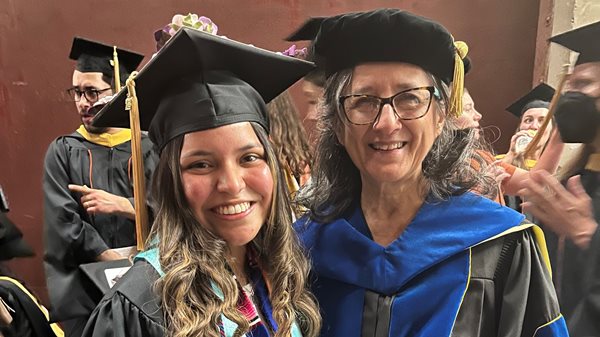< Go Back to Full Educator | Resource List
June 2022 Educator|Resource of the Month
The Center for Diversity and Social & Economic Justice(Opens in a new window) Educator|Resource is a monthly feature that highlights curricular resources and social work educators who address diversity and justice.

First-generation student, Kollete Zamora, and her BSW honors thesis supervisor, Diversity Center Director, Dr. Yolanda Padilla.
Achieving Equitable Student Success:
Teaching Anchored in Student Experiences
This past month many of us enjoyed seeing our first-generation students of color defy the odds and graduate. According to the research(Opens in a new window), aside from a lack of academic preparedness, first-generation students of color face increased psychological and social difficulties resulting from cultural differences, stigma surrounding low socioeconomic status, racial discrimination, and marginalization. What all these factors have in common is that they have to do with the learning environment. In this Educator|Resource we show how to shape a learning environment in the classroom that supports students of color by using a three-pronged approach: learning their stories, including learning materials that reflect their lives, and involving them in the development of the course curriculum.
CSWE Educational Standards:
A Learning Environment Where All Students Can Thrive
We focus on achieving equitable student success by creating learning environments characterized by “the culture of human interchange, the spirit of inquiry, and the support for difference and diversity” as outlined by CSWE Educational Policy 3.0. See more in 2015 Educational Policy and Accreditation Standards (EPAS), p. 14. This aspect of social work education, the implicit curriculum, helps fulfill part of an integrated curriculum design by focusing on diversity in the learning environment. It is considered as important as the explicit curriculum in shaping the professional character and competence of social work graduates. Developing this type of learning environment requires faculty of diverse backgrounds. In the experience of Black educators interviewed for Through Our Eyes: Perspectives and Reflections From Black Teachers(Opens in a new window) (pp. 6–7), beyond teaching content, educator-student experiential similarities can help build connections with students and “help them to understand a little better . . . what it takes to be successful, in this world.” Although the report is based on a study of K–12 educators, similar views are reflected on the part of Black faculty in higher education (see “On the Importance of African-American Faculty in Higher Education: Implications and Recommendations”(Opens in a new window)). Both bring thoughtful perspectives on the importance for all students of the culture of human interchange for learning to communicate and function effectively across cultures.
Teaching Resources
Learning about the lives of students of color through their narratives
Racialized Trauma and Healing: Latinx Social Workers Share Their Stories
Educators can learn what students of color wish their professors knew about their concerns. Drawing from videos and other materials provided in this Educator|Resource, students and educators can learn about the stories of Latinx and Black social workers as they share their stories of racialized trauma, resistance, and healing in the contexts of their academic and professional lives. In a learning environment that supports diversity, the stories can serve as mirrors for some students and as windows for others. Learn more.
Sample Resources
- School Social Work | Sharing My WHY + Latina College Experience(Opens in a new window), Lauren Gutierrez, LCSW (Video 6:27)
- Melanated Social Work | Why Social Work, Micro Aggressions and Endless SW Resources for BIPOC [Growing Up as a Queer Bisexual Black Man](Opens in a new window) Lauren Gutierrez, LCSW and Marvin Toliver, LCSW (Video 9:25)
- Latinx in Social Work Book Launch(Opens in a new window), Erica Priscilla Sandoval, LCSW (Video 1:43)
Additional resources
- Students Reflect on Personal Experiences as Asian Americans(Opens in a new window), by Alexis Stark, School News Network
- What My Asian and Asian American Students Want Their Teachers to Know(Opens in a new window), by Jennifer C. Mann, EducationNC
- Student Voices: Hearing and Supporting Native/Indigenous Students(Opens in a new window), by Charlie Scott, The Education Trust
Reflecting students' lives in our teaching
Decolonizing the Curriculum: Communities Reclaiming Their Stories
Including teaching materials that reflect the lived experiences of students makes learning more relevant. One of the things that comes out of the stories by students of color is their desire that a holistic picture of their backgrounds and of themselves be represented in what they are learning. Decolonizing the curriculum requires removing the layers of harmful narratives that have been created by others about communities of color. Using the Latino community as a case study, in this Educator|Resource we provide a curriculum template that helps students learn about communities based on their own stories. Learn more.
Sample resources
- In this news feature(Opens in a new window) and short video, seven young Hispanics reflect on how navigating their parents’ culture in the United States has shaped their views on what it means to be American.
- In a video interview(Opens in a new window) about her work, Afro-Dominican author and slam poet Elizabeth Acevedo(Opens in a new window) shares her inspiration for her two award-winning novels.
- The Rise of Regional Latin Music, Part I: Mexican Music Genres presents music videos(Opens in a new window) of six rising stars in regional Latin music performing songs from diverse genres: mariachi, banda, norteño, corrido, grupero, and fusion.
- Rethinking Stereotypes About Asian American Students Through Learning History: The Asian American Youth Leadership Initiative(Opens in a new window), by Jinhee Kim and Sohyun An, Childhood Explorer
See also related Educator|Resources
Involving students in the development of the course curriculum
Equity in the Classroom: A Template for Co-Creating a Course With Our Students
An avenue to facilitate both understanding and relevance is the co-creation of courses with the students, particularly the incorporation of learning materials selected by the students within the learning objectives of the course. This gives students the opportunity to further explore things that are important to them based on their lived experiences. In this Educator|Resource we share a full course template, including a syllabus, readings, and teaching activities, that educators can use to advance equity in the classroom by engaging students as partners in teaching and learning. Learn more.
- How I Introduce My Co-created Course to My Students
- Presemester Student Survey
- Syllabus
- Learning Course Plan
- Case Study Notes
- Prompts for Critical Thinking
The views expressed in the Educator|Resource are those of the educator(s) and do not necessarily reflect the views of the Council on Social Work Education.
Contact Dr. Yolanda Padilla, CSWE Diversity Center Director, at ypadilla@cswe.org.
